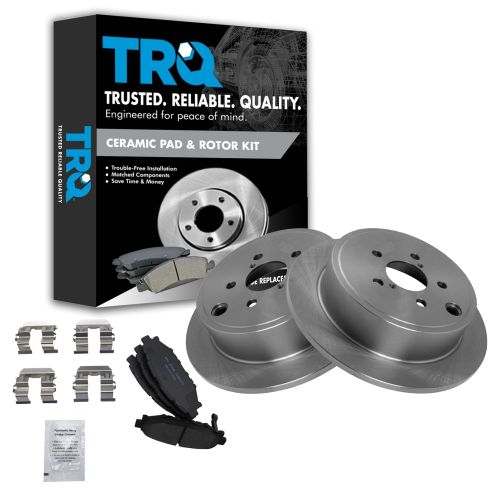1ABFS00526-Subaru Rear Ceramic Brake Pad & Rotor Kit TRQ BKA10717

Replaces
2011 Subaru Outback H4 2.5L Rear Ceramic Brake Pad & Rotor Kit TRQ BKA10717

Product Reviews
Loading reviews
4.71/ 5.0
31
31 reviews
Same quality as the originals
February 20, 2017
Pretty good price and same quality as the originals.
March 3, 2017
Parts arrived sooner than anticipated. Went together great. Vehicle is performing well after the repair
Brake rotors and pads
June 27, 2017
The mechanics who installed these said he has used this manufacturer before and said they are higher quality than what came factory on my car.
Brake kit
November 4, 2017
Was the easiest brake job I ever did. Great parts at a great price and quick delivery
Excellent service , fast
December 6, 2017
Wow, it's nice to feel you got more than expected!
Great prices, fast, and great quality. Highly recommend!!!
Just the right patts
April 16, 2018
Priced right quality . Delivered on time . Makes car repairs
more affordable . My go to parts supplier.
High quality easy fit
September 28, 2018
I have now put these brakes on all of my cars, arrived quickly, easy to install high quality and excellent wear
January 12, 2019
Very good product affordable past shipping good customer service
Easy to order and options are there just read
January 31, 2019
Great prices easy to order correct parts I have told everyone about this place even my service dept in which I work you will get all of my parts needs for all four of my vehicles great place to shop for quality parts
Perfect Fit
February 27, 2019
Fit perfectly in my 2011 Subaru Legacy Premium. Smooth breaking and no noise. Great alternative to paying a dealer tons of money to do your breaks!!!
Easy as the video showed it to be
October 29, 2019
The parts were a snap to order and install.
Nice kit
November 15, 2019
Vented rotors.
Had to grind the pads to fit the caliper brackets.
Good parts, great customer service
March 23, 2020
first, I want to say how great the employees are at 1Aauto, I ordered a set of brakes (rotors and pads) the rotors were meant for my vehicle and they didn't fit, but the customer service fixed the issue quickly!
the brake pads are perfect!!
Exactly what I ordered
June 24, 2020
Set came with everything I needed, and fit my Outback perfectly.
1AAuto does it again.
parts as advertised
January 21, 2021
everything came in a timely manner and it all fit perfectly. the video was great and made it easy. only one comment on the video: make sure to insert the brake pads with the pad sides facing each other. i know this seems obvious, but they can be put on backward. i got in a hurry on the second set and put one in backwards...caught the error just prior to putting things back together
Brake Parts
February 23, 2021
I would recommend this product and any others sold by 1A Auto. They have excellent customer service, fast shipping, and better pricing than local auto parts stores. Even with these benefits, they don't shortcut on product. The products are always good.
Worked on my 2013 Outback 2.5i premium, feel good
June 12, 2021
I put them on my 2013 Subaru Outback 2.5i premium this morning following the video on their YouTube channel. Took me a few hours to install, and I've driven around about 10 miles so far trying to bed them. They feel good.
2014 Subaru Legacy rear brakes and rotors
August 23, 2021
brakes and rotors arrived fast and I didn't pay an arm and a leg. fit perfectly.
reasonable kit
September 30, 2021
good price, decent quality
Rotor rusted
October 6, 2021
The fit is good and the installation is very easy. However, the hub section on the rotors are rusted already after just 4 months.
Warped Rotor
November 16, 2021
I received a warped rotor. Car shakes violently when braking at highway speeds.
Brakes Fit and install was smooth with video guidance
November 17, 2021
Every component of the package fit as described for my 2011 Subaru Outback and was simple to install. The Youtube video on installation was very helpful and easy to follow. I love how 1A Auto has videos for installation guidance. Everything about job went smoothly.
Perfect fit
August 7, 2022
Fast delivery and perfect fit. Would recommend to others.
Works for me
August 10, 2022
Fit right, work right. Can't ask for much more.
Great!
August 17, 2022
Pads are great so far. Didn't need the rotors and 1A refunded just the rotors. Perfect service!
Subaru rear brakes
September 21, 2022
Correct parts, great quality and quick delivery. I am very satisfied.
100% DIRECT FIT
July 14, 2023
Excellent Product
2013 Subaru Outback
September 22, 2023
Excellent product in fit and cost. Arrived 2 days after placing order and was at least 30% less than what the local auto stores were charging!
Great Brake overhaul kit
November 25, 2023
These rotors and pads were a direct OEM replacement, still like new over a year later. TRQ parts are well made and very reliable.
Thanks 1AAuto.
Quality
April 10, 2024
Quality parts that are exact fit and work well
September 17, 2024
Great product and fitment
Customer Q&A
How many rotors come with this orderSubaru Rear Ceramic Brake Pad & Rotor Kit TRQ BKA10717?
September 10, 2021
10
This will come with a set of two rotors.
September 10, 2021
Emma F
10
2
October 1, 2021
Edward W
Subaru is a registered trademark of Fuji Heavy Industries Co., Ltd. 1A Auto is not affiliated with or sponsored by Subaru or Fuji Heavy Industries Co., Ltd.
See all trademarks.











